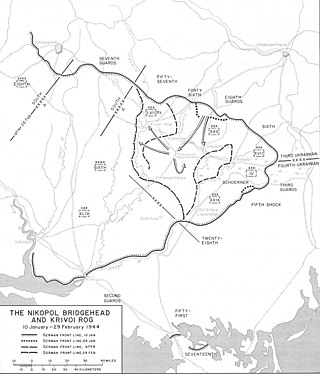
Operation Jubilee or the Dieppe Raid was a disastrous Allied amphibious attack on the German-occupied port of Dieppe in northern France, during the Second World War. Over 6,050 infantry, predominantly Canadian, supported by a regiment of tanks, were put ashore from a naval force operating under the protection of Royal Air Force (RAF) fighters.

No. 4 Commando was a battalion-sized Commando unit of the British Army during the Second World War formed in 1940. Although it was intended to conduct small-scale raids and harass enemy garrisons along the coast of German-occupied France, the unit was mainly employed as a highly trained infantry assault unit.

The Western Front was a military theatre of World War II encompassing Denmark, Norway, Luxembourg, Belgium, the Netherlands, the United Kingdom, France, and Germany. The Italian front is considered a separate but related theatre. The Western Front's 1944–1945 phase was officially deemed the European Theater by the United States, whereas Italy fell under the Mediterranean Theater along with the North African campaign. The Western Front was marked by two phases of large-scale combat operations. The first phase saw the capitulation of Luxembourg, Netherlands, Belgium, and France during May and June 1940 after their defeat in the Low Countries and the northern half of France, and continued into an air war between Germany and Britain that climaxed with the Battle of Britain. The second phase consisted of large-scale ground combat, which began in June 1944 with the Allied landings in Normandy and continued until the defeat of Germany in May 1945 with its invasion.

Kurt Zeitzler was a Chief of the Army General Staff in the Wehrmacht of Nazi Germany during World War II.
Operation Jubilee was the Allied code name for the raid at Dieppe on the French coast on August 19, 1942. The following order of battle lists the significant military units that participated in the battle, or were available as reserve.

The 10th Panzer Division was an armoured division in the German Army, the Heer, during World War II, established in March 1939.

The 709th Static Infantry Division was a German Army infantry division in World War II. It was raised in May 1941 and used for occupation duties during the German occupation of France in World War II until the Allied invasion. It was on the Normandy coast when the invasion occurred and so fought in the Battle of Normandy. The division was trapped in the Cotentin Peninsula and destroyed in the defense of Cherbourg.

The Northwestern Front was a military formation of the Red Army during the Winter War and World War II. It was operational with the 7th and 13th Armies during the Winter War. It was re-created on 22 June 1941, the first day of the Eastern Front on the basis of the Baltic Special Military District. On 22 June the Front consisted of the 8th, 11th, and 27th Armies, as well as the 5th Airborne Corps and the headquarters of the 65th Rifle Corps.

Operation Overlord was the codename for the Battle of Normandy, the Allied operation that launched the successful liberation of German-occupied Western Europe during World War II. The operation was launched on 6 June 1944 (D-Day) with the Normandy landings. A 1,200-plane airborne assault preceded an amphibious assault involving more than 5,000 vessels. Nearly 160,000 troops crossed the English Channel on 6 June, and more than two million Allied troops were in France by the end of August.

The Battle of the Kerch Peninsula, which commenced with the Soviet Kerch-Feodosia Landing Operation and ended with the German {{Operation Bustard Hunt, was a World War II battle between Erich von Manstein's German and Romanian 11th Army and the Soviet Crimean Front forces in the Kerch Peninsula, in the eastern part of the Crimean Peninsula. It began on 26 December 1941, with an amphibious landing operation by two Soviet armies intended to break the Siege of Sevastopol. Axis forces first contained the Soviet beachhead throughout the winter and interdicted its naval supply lines through aerial bombing. From January through April, the Crimean Front launched repeated offensives against the 11th Army, all of which failed with heavy losses. The Red Army lost 352,000 men in the attacks, while the Axis suffered 24,120 casualties. Superior German artillery firepower was largely responsible for the Soviet debacle.
The 1st Army Corps was first formed before World War I. During World War II it fought in the Campaign for France in 1940, on the Mediterranean islands of Corsica and Elba in 1943 - 1944 and in the campaigns to liberate France in 1944 and invade Germany in 1945.

The 1st Special Service Brigade was a commando brigade of the British Army. Formed during the Second World War, it consisted of elements of the British Army and the Royal Marines. The brigade's component units saw action individually in Norway and the Dieppe Raid, before being combined under one commander for service in Normandy during Operation Overlord. On 6 December 1944, the Brigade was redesignated 1st Commando Brigade, removing the title Special Service and its association with the German SS.
The 6th Canadian Infantry Brigade was an infantry brigade of the Canadian Army that fought during World War I and World War II. Raised in 1915, it formed part of the 2nd Canadian Division and fought on the Western Front during World War I before being disbanded. Later, it was re-raised in September 1939 and subsequently took part in Allied operations in north-west Europe in 1944 and 1945.

The Fallschirmjäger were the paratrooper branch of the German Luftwaffe before and during World War II. They were the first paratroopers to be committed in large-scale airborne operations. They were commanded by Kurt Student, the Luftwaffe's second-in-command.

The Nikopol–Krivoi Rog offensive was an offensive by the Red Army's 3rd Ukrainian Front and elements of the 4th Ukrainian Front against the German 6th Army in the area of Nikopol and Krivoi Rog in Dnipropetrovsk Oblast in central Ukraine between 30 January and 29 February 1944. It took place on the Eastern Front of World War II and was part of the wider Dnieper–Carpathian offensive, a Soviet attack against Army Group South to retake the rest of Ukraine that fell to Germany in 1941.
The 302nd Rifle Division began service as a specialized Red Army mountain rifle division, which saw service in the disastrous operations in the Crimea in early 1942. It was later converted to serve for the balance of the war as a standard rifle division. The division played a leading role in the 51st Army's breakthrough south of Stalingrad in the opening stages of Operation Uranus, and then in the exploitation following this success; however, it was badly battered and routed in the initial stage of the German Operation Winter Storm. After recovering from this, the division continued to turn in a creditable record of service in the southern sectors of the Soviet-German front for the duration, and was especially recognized for its role in the liberation of the city of Ternopol, for which it received that city's name as an honorific.
The 335th Infantry Division was an infantry division of the German Army during the Second World War, active from 1940 to 1944. It saw active service in France and on the Eastern Front and was destroyed in fighting in Romania in August 1944.

The 376th Infantry Division was an infantry division of the German Army during World War II, active from 1942 to 1944 in two separate instances.
German XXXXIV. Corps was a corps in the German Army during World War II.
The 224th Rifle Division was an infantry division of the Red Army, originally formed as one of the first reserve rifle divisions following the German invasion of the USSR. A large part of this first formation took part in amphibious landings near Kerch in late December 1941 but it was encircled and destroyed during the Battle of the Kerch Peninsula in May 1942.













